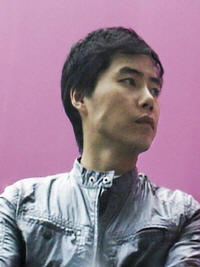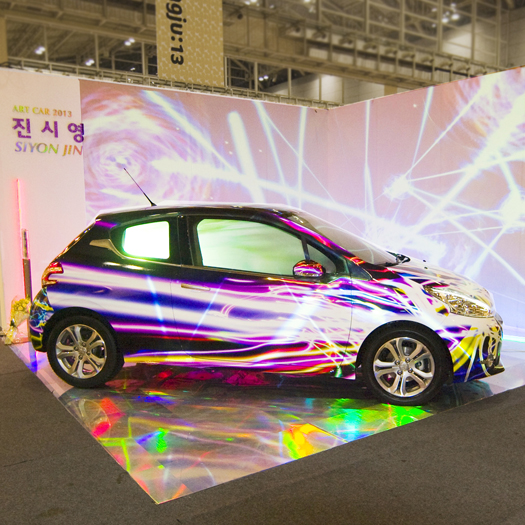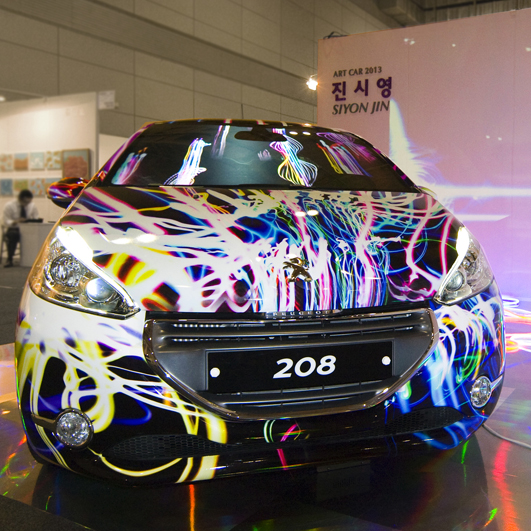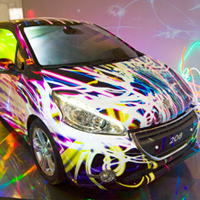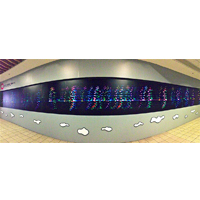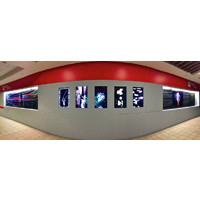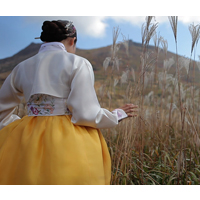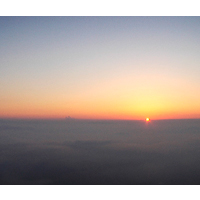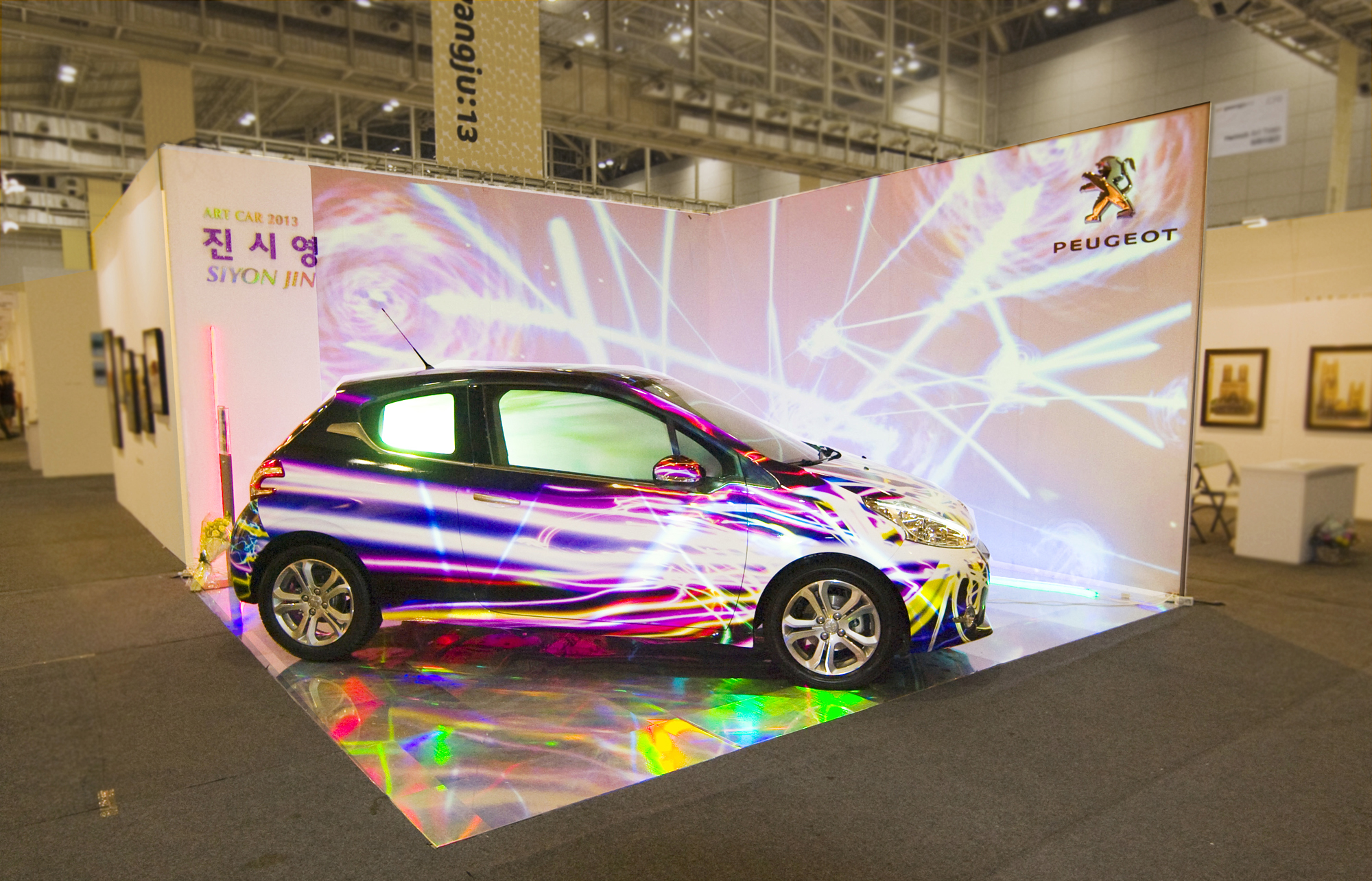
SIYON JIN & PEUGEOT ART CAR, Art Gwangju 13, 2013
PEUGEOT208, Single channel video projection, 3channel video projection on car window, Sound, Line LE, Variable size
Siyon JIN: Light & Communication, and Human
Jin Siyon majored in new forms at the Pratt Institute, School of Art and Design in New York. He returned home to Korea after graduation. Jin produced Human Maze (2004), a 4-channel video projection that metaphorically depicts a human being as an animal in a labyrinth as if in a laboratory experiment. It was presented at the 4th Seoul International Media Art Biennale (2006). The same year, Jin was invited to The 6th Gwangju Biennale 2006, where he presented Fragments of Everyday Lives in Gwangju (mixed media installation, 5 PDPs, 1 video projection on screen), which shows documentary images of the ordinary lives of the people of Gwangju. He continued to produce a number of site-specific video installation works about things that are disappearing in the face of urbanization through the Alley series (2006). In 2008, noting the potential of LED lighting, Jin began working on a pictogram system utilizing LEDs. Each LED serves as a single pixel, rather like a dot on the canvas of a George Seurat painting. He has since used the pictogram as a component of media work, that is, motion pictures on sculptural, three-dimensional screens of varied forms.
The same year, during the invitational exhibition at Vit Gallery, the Insa-dong branch of Gwangju Museum of Art, Jin showed Wave (2008), a sculpture that appeared to be an undulating form of waves, which by LEDs projected seemingly three dimensional sunrises and sunsets in the form of motion pictures. Wave garnered a great deal of attention and excitement, and Jin immediately afterwards produced Linking Spot, a large-scale LED display which represents the hectic everyday life and communication of contemporary man through a cartoon figure. This was his first public art project. By then, Jin was very interested in expressing images of urban dwellers going about their busy lives, represented by pictograms as points of light in graphic animation. In his graphic animation, he shows dynamic images starting with joyful dance joined by all people, the sparkling energetic life of urbanites, conflict and fusion of images entangled chaotically, and finally an orderly society with people cooperating together and mingling and communicating with each other without chaos. After intense research on media technology, he managed to create a perfect spherical screen of LEDs for Harmony (2009), which emits light images programmed by a geometric abstract algorism.
Focusing on the possibility of combination of movement and communication of people, Jin produced the Sign series (2010). This elicited some feeling of ambiguity since he had reverted from digital to analogue display. At a glance, the Sign series seems to be a humorous version of work by Jim Campbell (1956~), who captures body movement of actual people and coding it digitally, and Julian Opie (1958~)'s animated work which used LEDs. However, it can be said that if Campbell and Opie applied algorisms of movement in reverse by extracting individual distinguishing characteristics from the movements of people by entering movements of actual objects or attaching motion indicators to major body parts, Jin recomposes the movements of beats in an analogue way by programming or entering body movements and using the well-structured movements of an individual and human interaction as abstract software. Also, Jin’s programmed human body is at the spot which maintains the total system as an interface with data space such that mutual exchange and the diversity of all senses do not decline, not to mention visual sense. The Sign series is about the human as a social symbol and is a node of mutual communication. As William Ford Gibson (1948~) said in his cyberpunk novel Neuromancer (1982), the Sign series foreshadows the full-scale advent of the light human who is made of information granulation as a futuristic being moving in a network.
The marriage of technology and art has brought with it endless possibilities for experimentation in visual art from space-time to time. Representative avant-garde artists of the early 20th century - Marcel Duchamp, Man Ray, Laszlo Moholy-Nagy - and radical anti-art experimentation by the Dadaists led the expansion of the realm of art into space-time called 'interaction' and 'virtuality' by introducing non-material elements and movements. Such experimentation, followed by the fateful encounter of Nam June Paik (1932~2006) and John Milton Cage (1912~1992) and the Fluxus movement, served as a catalyst for the birth of video art. At this point, Jin's recent series Flow (2011) faces familiar historical moments. In many respects, the Flow series can be compared to psychedelic effects generating Merce by Merce (1975) which was produced by Nam June Paik, Charles Atlas, and Merce Cunningham (1919~2009), the innovative choreographer of modern dance, jointly with TV Lab at WNET/Thirteen. Merce by Merce is video art in a surrealist mood that simultaneously synthesizes diverse movements of the choreographer Merce Cunningham and his dance company dancing to electronic music by avant-garde composers including John Cage, and camera images shot at different angles with an analogue video mixer, while generating psychedelic effects to excite. Afterwards, Merce by Merce was often referenced in video clips including Cage in a Cage (1990), Dadaikseon (meaning 'the more, the better,' 1988) and Good Morning Mr. Orwell (1984), Nam June Paik's groundbreaking satellite intallation project.
As discussed earlier, Jin's Flow is read as a homage to electronic composition achieved by the great collective work of analogue video by Nam June Paik and his colleagues in that Flow is new media art by Jin that incorporates dance, music, and technology. However, compared with Nam June Paik, an anti-art avant-gardist who fiercely resisted traditional geographical, chronological, and medium-based approaches, the optimistic viewpoints of Jin Siyon are rather closer to the relation of photography, ballet, and movement of Edgar Degas, (1834~1917). LED lights, which are used as markers to exquisitely capture flowing water like movement of classical Korean dance to background music of gayageum (Korean harp), serves as a sensor for numerical representation of digital image and cybernetics of physical space, and the silhouette of pixels projects people as graphic icons onto an interface in dark space. The tracks of fast moving dances are simultaneously captured at various angles, which reminds us of the shooting technique of animal movement by Eadweard Muybridge (1830-1904). The track of light composed of bits of information is gently and flexibly curved in dark space and diffused in all directions. Tracks of electronic sparkles shining coldly like the glow of fireflies amplified a thousand times present indeterminate or organic movement in interactive cyberspace when the physical movement of a camera - horizontal panning, pendulum action, zooming, and rotation - is added.
Nam June Paik called himself a 'Stationary Nomad'. He devised the concept of stationary nomadism meaning 'send an idea or information far away from the place where one is seated.' This concept was linked to an idea of the 'Electronic Super Highway' in 1974 on which information runs at the speed of light. Nam June Paik's remarkable intuition and insight about the information superhighway with multiple connections from one dot or one place to another dot or another place like a cobweb wired with information light foreshadowed the advent of social networks such as ‘facebook' and 'twitter' for the far more complex and intertwined communication of today. Jin Siyon attempts to expand the movement of the human body in media space through the information network more visually, and this can be understood given the inseparability of art and culture and life. The ecological human body combines with media, and through individual separation of synesthesia it is immersed to experience amplification into an enormous network of light. Such experience of optical media will further the expansion of boundaries of senses as the domains of other people are mutually reflected in social relations.
Houng-cheol CHOI (Curator, Art Theory)
more
Man Begot Light, and then Flow
Light is attractive for artists. Since the Impressionists’ interest in light reflected images of objects and the world, followed by artists like Man Ray who searched the interiors of objects using light, artists have closely scrutinized and exposed contemporary man existing in a time that has become nearly ambiguous where distinctions between day and night has become blurred, a hybrid time in cities enveloped by artificial light with the advancement in science and technology.
Light is a medium that enables our vision to realize this world, and we can perceive an object with any clarity only when there’s light. Therefore light is inseparable from time and as we perceive the world through time, time is also the object of fascination for artists.
Jin Siyon has seriously incorporated LED in his artwork since 2008. In his work titled Wave, the filmed images of sunrise and sunset over the ocean were simultaneously projected in the format of LED sculpture. There may have been several reasons for incorporating LED into his work, of which the most important would be the artist's formatting of the ocean to autonomously lit and move. That is, the three dimensional structure required the use of LED to generate form, light, and motion. The palpable ocean is not a laminated mirage reflected on our retina, but a touchable and reachable entity that is visualized through artificial lighting.
Jin Siyon has seriously incorporated LED in his artwork since 2008. In his work titled Wave, the filmed images of sunrise and sunset over the ocean were simultaneously projected in the format of LED sculpture. There may have been several reasons for incorporating LED into his work, of which the most important would be the artist's formatting of the ocean to autonomously lit and move. That is, the three dimensional structure required the use of LED to generate form, light, and motion. The palpable ocean is not a laminated mirage reflected on our retina, but a touchable and reachable entity that is visualized through artificial lighting.
Investigation of man formed out of light
Firstly, hitherto artistic representations of light as meaning have symbolized man as an entity of light, recorded and edited his movements, and thereby expressing the currents of light movements. The roots of such an approach can be found in the recent developments in social networks. Represented foremost by Facebook, social networks have already conquered existing confines of physical space, and people on earth are now connected in real time by new online networks. Such novel relationship mappings have become a starting point to plot the course for the artist’s ‘humane’ viewpoints. Furthermore, the artist has begun to interpret individual beings as ‘light.’ The motions of one individual and the relationships derived from human liaisons, the connections between man and the world are represented as traces of light.
Firstly, hitherto artistic representations of light as meaning have symbolized man as an entity of light, recorded and edited his movements, and thereby expressing the currents of light movements. The roots of such an approach can be found in the recent developments in social networks. Represented foremost by Facebook, social networks have already conquered existing confines of physical space, and people on earth are now connected in real time by new online networks. Such novel relationship mappings have become a starting point to plot the course for the artist’s ‘humane’ viewpoints. Furthermore, the artist has begun to interpret individual beings as ‘light.’ The motions of one individual and the relationships derived from human liaisons, the connections between man and the world are represented as traces of light.
This was realized by such works as the media facade artwork using LED from 2010 titled, Sign1, which was further developed in Sign2 and Sign3. In the Sign1 series, the first examples of visualizing light as a human figure were Sign1_Lotte Department Store Media Facade_2010; Sign2_Single channel Video_2010; and Sign3_Seoul Square Media Facade_2010. And the first example of clothing a performer with LED costume and recording his movements started with Sign2 and Sign3. He then moved on to present traces of his data. The motions of the performer are expressed through movement and traces of light to create meaningful “relationships.” What’s interesting is that the artist appropriated a dance format to represent human motion. The artist uses dance which is motions of one individual as well as the body language used to communicate with the world, and an art of instinctive motions to record the motions of light in an attempt to analyze human existence. Thereby Jin Siyon uses the most natural and beautiful of human movement in expressing motion and traces of light to represent modes of connecting between man and his world.
Synthesis of Artificial and natural light
Another interesting aspect is the research into visual effects of light which the artist explores by synthesizing LED as artificial light and mother-of-pearl as natural light. The application of mother-of-pearl as a medium to experiment with visual effects may seem problematic considering the contextual complexity of mother-of-pearl; prone to oversimplification for its sensual visual effect and its connotations as a tradition-bound medium. But as the artist has continued to work with exploring the natural in technology, his choice of mother-of-pearl fits into place. Can the vivid and glaring artificial light harmonize well with mother-of-pearl’s natural light, or will it be totally outdone by artificial light? All these doubts have been answered by the form and shapes created by light, and the harmony and balance reached by arrangement. The dimensions of the monitor frame crafted out of mother-of-pearl have been adjusted to eye level, and the light projection is channeled above the frame. Harmony is reached by safeguarding the shapes and visual effects of each.
Another interesting aspect is the research into visual effects of light which the artist explores by synthesizing LED as artificial light and mother-of-pearl as natural light. The application of mother-of-pearl as a medium to experiment with visual effects may seem problematic considering the contextual complexity of mother-of-pearl; prone to oversimplification for its sensual visual effect and its connotations as a tradition-bound medium. But as the artist has continued to work with exploring the natural in technology, his choice of mother-of-pearl fits into place. Can the vivid and glaring artificial light harmonize well with mother-of-pearl’s natural light, or will it be totally outdone by artificial light? All these doubts have been answered by the form and shapes created by light, and the harmony and balance reached by arrangement. The dimensions of the monitor frame crafted out of mother-of-pearl have been adjusted to eye level, and the light projection is channeled above the frame. Harmony is reached by safeguarding the shapes and visual effects of each.
The artist’s experimentation with visual effects of light began with Wave from 2008. This LED projected image of sunrise and sunset used video recorded images of natural light with LED artificial lighting. That is, natural light is recorded with technical media and then projected through LED artificial light, whereas his most recent work records the movements of LED light which is represented together with naturally transmitted light. The artist is undergoing diverse experimentations with the visual effects and meaning of natural and artificial light use, which is not limited to experimenting with sensory dimensions of light but a study of the correlation between man's technological medium and nature.
Light has various contextual references for the artist. Light itself is the expression of man’s beautiful energy. The traces of light are like the shadows of the beautiful energy between mankind, and man and nature. At the same time, it is also the transporter that brings harmony between nature and manmade technological civilization. Such dramatic experimentation with light utilizes a diverse range of technological medium which have become the artist's tool to construct his uniquely personal output.
Sun Mi WOO (Instructor of Art Management at Kyunggi University)
more






